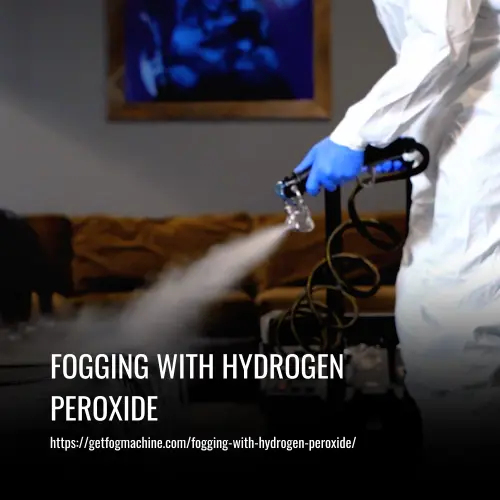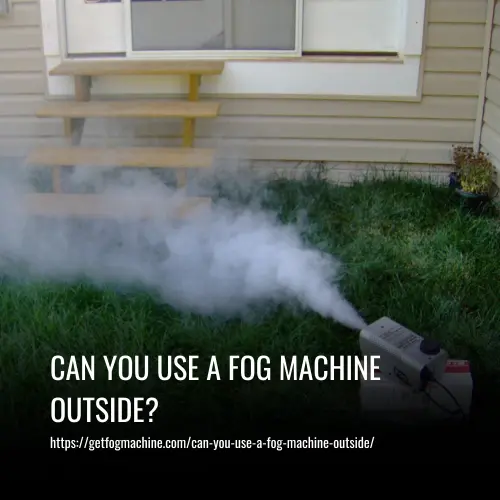Fogging with Hydrogen Peroxide: A Comprehensive Guide
This post contains affiliate links. As an Amazon Associate, we earn from qualifying purchases.
Hydrogen peroxide fogging, also known as H2O2 fogging, is an effective decontamination process that involves the release of aerosolized hydrogen peroxide into an enclosed area. This method is proven to eliminate a wide range of pathogens, including bacteria, viruses, and fungi, from various surfaces and environments.
Hydrogen peroxide fogging offers several advantages, such as its ability to reach inaccessible areas and leave no chemical residue. It is also known to have high antimicrobial efficacy and can be used in critical care patient rooms, intensive care units, and other high-touch surfaces.
This whole-room disinfection technique significantly reduces the risk of environmental contamination and nosocomial pathogens, leading to lower infection rates in healthcare settings. Hydrogen peroxide fogging is an essential tool in the fight against healthcare-associated infections and can complement standard cleaning and manual cleaning practices.

Can Hydrogen Peroxide be Used for Fogging
Yes, hydrogen peroxide can be used for fogging. The U.S. Environmental Protection Agency recommends the use of food-grade hydrogen peroxide for fogging spaces instead of chemical sanitizers like sodium hypochlorite. Hydrogen peroxide has been used for decontamination in hospitals and food-processing facilities, effectively eliminating a wide range of pathogens.
The EPA has even registered a fogging substance called Vaporised Hydrogen Peroxide, which is highly effective against bacteria, viruses, and fungi. Using hydrogen peroxide for fogging is a safe and affordable way to disinfect both surfaces and the air in your home or office.
How Does Hydrogen Peroxide Fogging Work
Hydrogen peroxide fogging is a disinfection process that involves releasing a fine mist of hydrogen peroxide into the air. This mist settles on all surfaces in the area, effectively killing a wide range of pathogens through mechanical and chemical means. Mechanically, the hydrogen peroxide disrupts the cell wall of the pathogens, while chemically it oxidizes enzymes and proteins.
The fogging process also helps reduce the population of pests and insects. Once the fog settles, the hydrogen peroxide dissipates into water and oxygen, leaving no harmful residues behind. This makes hydrogen peroxide fogging a safe and effective method for disinfecting various environments, including homes, offices, and healthcare facilities.
Is Hydrogen Peroxide Fogging Effective
Yes, hydrogen peroxide fogging is an effective method for eliminating a wide range of pathogens, including bacteria, viruses, and fungi. It achieves a “6-log kill” or “6-log reduction,” meaning that it can eliminate up to 99.9999% of pathogens present.
Aerosolized hydrogen peroxide is highly efficient in decontaminating spaces, making it an excellent choice for disinfecting homes, offices, and healthcare facilities. This method is capable of reaching areas that are difficult to access with standard cleaning methods, ensuring that high-touch surfaces and environmental pathogens are effectively eliminated.
Its effectiveness in reducing infection rates and controlling nosocomial and hospital-acquired infections has been well-documented, making hydrogen peroxide fogging a beneficial option for maintaining a safe and sanitized environment.
Why is Hydrogen Peroxide Fogging Efficient
Hydrogen peroxide fogging is a highly efficient method of disinfection for a variety of reasons. From targeting microbes on a molecular level to reaching all surfaces and being environmentally friendly, hydrogen peroxide fogging offers several advantages.
1. Targeting Microbes on a Molecular Level
One key reason for the efficiency of hydrogen peroxide fogging is its ability to target microbes on a molecular level. The mist produced during the fogging process is capable of penetrating all surfaces, eliminating any microbes present.
This includes even the most resilient strains, such as antibiotic-resistant bacteria. By reaching into every nook and cranny, hydrogen peroxide fogging ensures that hidden areas are thoroughly disinfected, leaving no place untouched.
2. Reaching All Surfaces
Aerosolized hydrogen peroxide settles on all surfaces, including cracks and crevices. This comprehensive coverage guarantees that every part of the treated area is fully disinfected.
There is no place where the mist won’t go, making hydrogen peroxide fogging remarkably effective in eliminating pathogens. This method ensures that the decontamination process is thorough and leaves no room for potential conflicts.
3. Biodegradable and Environmentally Friendly
One notable advantage of hydrogen peroxide fogging is that it is biodegradable and environmentally friendly. After the disinfection process, hydrogen peroxide breaks down into water and oxygen, leaving no harmful residues behind.
This makes it a safe choice for disinfecting various settings, including homes, offices, and critical care centers. The use of hydrogen peroxide fogging contributes to reducing the environmental impact while effectively disinfecting high-touch and contaminated surfaces.
Benefits of Fogging with Hydrogen Peroxide
Hydrogen peroxide fogging has gained popularity as an effective method for eliminating harmful pathogens and maintaining a clean environment. This disinfection technique offers several advantages that make it a preferred choice for many individuals and businesses.
1. Affordability
Compared to other chemical sanitizers available on the market, hydrogen peroxide is an affordable disinfectant. It is a cost-effective solution for maintaining a hygienic space without breaking the bank.
2. Safety
One of the key benefits of hydrogen peroxide fogging is its safety to use. There are no harmful fumes or residues left behind after the process. This makes it a suitable option for various environments, including homes, offices, and hospitals, without posing risks to the health of occupants.
3. Quick and Easy
Hydrogen peroxide fogging is a quick and straightforward process. With minimal setup time, it allows for efficient disinfection in just a matter of minutes. Its ease of use makes it accessible to everyone without the need for specialized training or equipment.
4. Compatibility
Another advantage of hydrogen peroxide fogging is its compatibility with other disinfectants. It can be used alongside chemicals like bleach or alcohol, allowing for a customizable disinfecting solution that suits specific needs. This versatility enhances its effectiveness against a wide range of pathogens, including bacteria, viruses, and fungi.
5. Residue-Free
Unlike some disinfectants, hydrogen peroxide fogging does not leave behind any chemical residue. This ensures a safe and clean environment without concerns about harmful residues that could potentially impact human health. It is an ideal option for maintaining hygiene and preventing the spread of infectious agents on surfaces.
Disadvantages of Hydrogen Peroxide Fogging
Hydrogen peroxide fogging is an effective decontamination process used to eliminate a wide range of pathogens from various surfaces. However, this method does have a few disadvantages that need to be taken into consideration.
1. Corrosion
One of the drawbacks of hydrogen peroxide fogging is its potential to promote corrosion. Being an oxidizing agent, hydrogen peroxide can quickly corrode metals, rubber, and plastic if not used properly. It is important to follow the manufacturer’s instructions carefully, ensuring that the fogging solution is compatible with the surfaces or equipment it is being used.
2. Residue
Another disadvantage is the residue that can be left behind after the fogging process. If not properly cleaned off, the chemical residue can lead to potential conflicts in certain environments or with sensitive equipment.
3. Health and Safety
Hydrogen peroxide can also pose risks to health and safety if mishandled. When using hydrogen peroxide fogging, it is important to follow proper safety protocols and use appropriate personal protective equipment to prevent exposure to the chemical.
Tips for Using Hydrogen Peroxide Fogging
Hydrogen peroxide fogging is an effective method for disinfecting spaces such as homes or offices. However, it is important to follow certain tips to ensure the process is carried out safely and effectively.
1. Ensure proper ventilation
Before starting the fogging process, ensure that the area to be treated is well ventilated. Hydrogen peroxide fogging releases a significant amount of moisture, which can lead to condensation on surfaces if the space is not properly ventilated.
2. Follow the manufacturer’s instructions
It is crucial to carefully read and follow the manufacturer’s instructions when using hydrogen peroxide fogging. This will ensure that you are using the product appropriately and maximizing its effectiveness.
3. Be cautious around metal surfaces
Hydrogen peroxide has the potential to promote corrosion on metal surfaces. Take extra care when fogging near metal objects or surfaces and adhere to the manufacturer’s instructions to prevent any damage.
4. Take precautions with electronic equipment
As an oxidizing agent, hydrogen peroxide can potentially damage electronic equipment. Therefore, it is important to handle fogging near electronic devices with care to avoid any harmful effects.
By following these tips, you can effectively and safely use hydrogen peroxide fogging to disinfect your surroundings. Remember to always prioritize safety and carefully read and adhere to the manufacturer’s instructions for optimal results.
FAQs
Hydrogen peroxide is safe for humans when used properly. However, it is important to take precautions when using it and to follow the manufacturer’s instructions carefully. While you can safely use hydrogen peroxide for fogging, it is toxic if ingested in high doses.
Yes, fogging with hydrogen peroxide is definitely worth it. It is a quick, easy, and effective way to disinfect your home or office. Manual cleaning is important, but it is no substitute for chemical fogging. Fogging can eliminate unwanted viral contaminants like COVID-19 and ensure your indoor environment is safe and clean.
Hydrogen peroxide is safe for humans when used properly. However, it is important to take precautions when using it and to follow the manufacturer’s instructions carefully.
Yes, hydrogen peroxide is used in various forms for the fumigation of rooms, equipment, and filters. It is a versatile fumigation method and can be effective in eliminating harmful pathogens.
Yes, studies have shown that hydrogen peroxide can rapidly eliminate 99.99% of SARS-CoV-2 on different types of fabrics. It can effectively be applied as a disinfectant to reduce the further spread of COVID-19 through fabrics.
Hydrogen peroxide offers several advantages over traditional formaldehyde fumigation. It is non-carcinogenic and requires a much shorter contact time. It is a preferred choice for fumigation due to its effectiveness and safety.
Conclusion
Fogging with hydrogen peroxide is a powerful and effective method for sanitizing and disinfecting your space. Whether you’re looking to combat viruses, bacteria, or mold, hydrogen peroxide fogging can help keep you and your loved ones safe and healthy.
So why wait? Give it a try and say goodbye to harmful pathogens and hello to a clean and fresh environment. Your health and peace of mind are worth it!






